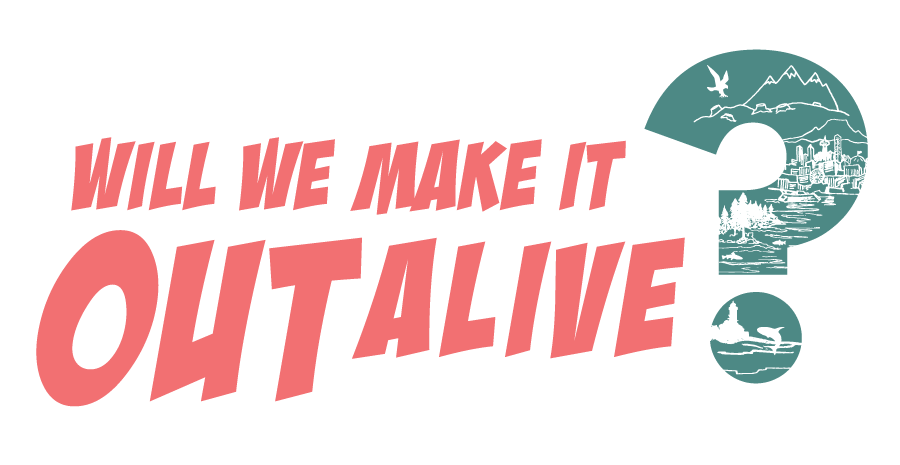Will We Make Out Alive? No.
/Did you miss the National Climate Assessment Report that came out on Black Friday? Coincidence…I think not…The assessment was compiled by over 300 scientist from the US government; Trump’s response to the report, “It’s fine” and “I don’t believe it.” Unfortunately, if you actually look at the report, that is not the outlook that it paints. Is it fire and brimstone…well basically…We are slated to experience the impacts of sea level rise, more natural disasters, increased forest fires, crappy air, messed up water cycle impacts and most likely we will not make it out alive. Meanwhile, while those things are all sucktastic, we, in the US, will also be dying younger (yes the annual US mortality rate just went down…again…for the 3rd year in a row!).
WHACK FACT: Jen the Magical Mapper is right on the edge of two age groups; one of which will make it out alive later in life and the other of which will die sooner…Guess that means she gets to choose her own adventure.
Their website does a nice job of summarizing the data based on regional areas. I am going to dive a little deeper into the forecasted impacts to the Pacific Northwest. Their key message for our region is that we will have water related impacts that will have “far reaching ecological and socioeconomic impacts” to our region. One of the biggest impacts will be the warming climate itself and the effects that has on our watersheds and the timing and amount of streamflow. We are already experiencing increased storm intensity and that is also predicted to continue.
Then there are all sorts of ripple conditions that will happen from this offset of our hydrologic cycle. This will include decreased water in the summer, making for tougher decisions when it comes to water rights and water use especially around irrigation for agricultural lands and consumption for people! Trees and plants that are stressed will be more susceptible to insects and disease.
For example, in snow dominated watersheds, we will see less snow pack (because it is warmer), which will result in increased river flows in the winter. Currently the snowpack lasts into the spring before becoming meltwater, which is slowly released into our rivers starting in late spring with the highest average flows in June or July. Under the climate forecasts, that same precipitation that currently comes down as snow in the winter will be rain through much of the year…by 2080, even under the mitigated emissions scenario, our peak flows will occur in February. This will result in much lower summer flows, which will also be warmer.
“Why do you always have to be so negative?”
And one of the very important ecosystem functions of our large forests in the Pacific Northwest is to sequester carbon (that’s cause they “breath in” carbon dioxide and put the carbon in their tree bits). Oh, oh, oh, oh…staying alive…as in, as long as that tree is staying alive that carbon is all up in its tree bits and it not out in our atmosphere increasing greenhouse gases. So, when those trees are burned up in a forest fire or even when they are cut down or die they release the carbon that was stored up in there tree bits back into the carbon cycle where it can end up as a greenhouse gas in our atmosphere…FURTHER COMPOUNDING the impacts of climate change.
Meanwhile, warmer and lower flows in our rivers will impact all sorts of plants and animals that have spent at least the last 10,000 years (since the last ice age) perfecting their growing habits for our current climate conditions. Yes, adaptations can be made by natural organisms, but can they keep up with the accelerated rate? Under some scenarios, by 2080, we would see conversion of sub-alpine forests to other types of forests.
Our coastal areas will also see impacts both from sea level rise and from increased river flows during the winter season, and let’s not forget about the impacts of ocean acidification on our shellfish and the related industries. Our low lying coastal areas will see increased flooding in urban areas as stormwater systems overflow from the increased winter flows and at the same time they may be impacted by high tides that surge or push water from the marine areas into our existing pipes and conveyances, which typically are placed to prevent marine water from flowing back into the stormwater system. However, as the marine waters rise, they will follow the path of least resistance, which will backflow into the stormwater system and if the system gets enough flow will result in water pushing out of catch basins and manholes. Let’s not forget, this will be brackish water and is likely to have marine water species that get brought into our freshwater conveyances and then end up dying.
Of course, for those that do not think these impacts will affect humanity (they will, though!); there is also a 500 billion dollar price tag associated with the impacts of climate change. So, this is going to have a HUGE impact on our salmon, forests, rivers, agriculture and ultimately our health.
Remember not breathing for like two months last summer? Get ready for more of that! Asthma and breathing related diseased are expected to increase due to poorer air quality resulting from increased forest fires.
And those are just some of the highlights of the impacts to the Pacific Northwest. Check out the full report and all of the SCIENCE that went into.



Find out how Jen the Magical Mapper has been doing on her Plastic Free July challenge!